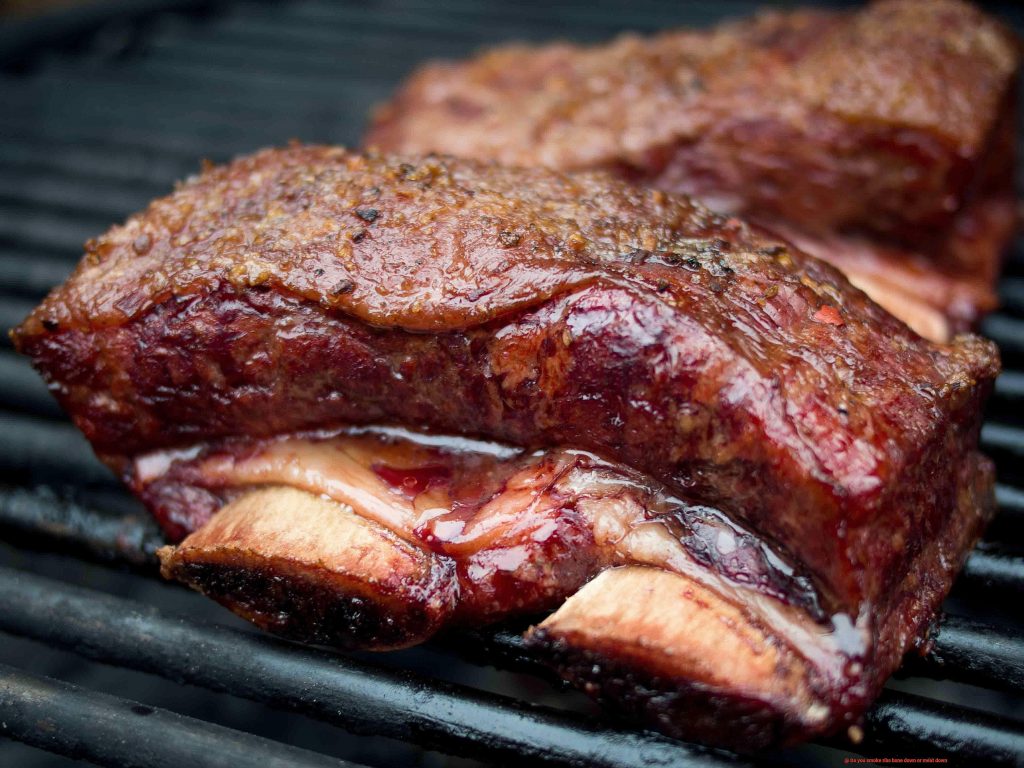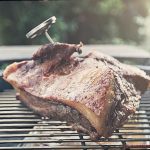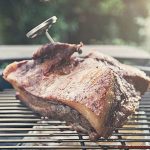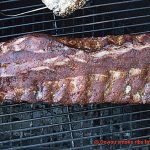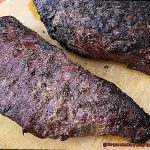Imagine sinking your teeth into a juicy and perfectly cooked smoked rib, the meat falling off the bone with every bite. As a pitmaster or an amateur enthusiast, you’ve likely heard of the age-old debate on whether to smoke ribs bone down or meat down. It’s a topic that sparks heated discussions and passionate opinions.
Some swear by smoking ribs bone down, arguing that it allows for more even cooking as the bones act as insulation from the heat. Others are adamant that smoking ribs meat down is the way to go, as it allows the meat to baste in its own juices, resulting in a more flavorful and tender end product.
But which method is truly superior? To answer this question, we need to delve into the science of smoking ribs. However, there are also practical considerations such as the type of smoker you’re using and cooking time and temperature. Furthermore, different cuts of ribs may require different methods.
In this blog post, we aim to settle this debate once and for all by providing expert insights and tips on whether to smoke ribs bone down or meat down. So grab yourself a cold drink and get ready to learn all there is to know about smoking ribs like a pro.
Contents
What is Smoking Ribs?
This cooking method involves using smoke and low heat for an extended period of time, resulting in mouth-watering ribs that are sure to impress your guests.
To begin smoking ribs, you’ll need a smoker or grill with a smoker box. The smoker box is filled with wood chips that are ignited to produce smoke. Once the smoke is flowing, the ribs are placed on the grill racks either bone down or meat down, depending on your preference.
When smoking ribs bone down, the bones act as a natural heat shield, protecting the meat from direct heat and preventing it from drying out. This method also allows for better smoke penetration into the meat and can result in a more tender end product. Conversely, smoking ribs meat down can create a crispier bark on the meat side and allows for any excess fat to render off and drip away from the meat.
Smoking ribs is a slow process that requires patience and attention to detail. It can take anywhere from 3-6 hours depending on the temperature and size of the ribs. To ensure even cooking, it’s important to monitor the temperature regularly and adjust the smoker as needed.
The end result of smoking ribs is fall-off-the-bone tender meat that is bursting with flavor. You can experiment with different types of wood chips such as hickory, applewood, or mesquite to create unique flavor combinations. Additionally, seasonings like dry rubs or marinades can be used to enhance the taste even further.
The Debate: Bone Down vs Meat Down
Some swear by cooking their ribs with the bones facing down, while others argue that the meat should be facing down. So which method is better? Let’s dive into the details.
The Bone Down Method:
Grill masters who prefer the bone down method believe that it helps protect the meat from direct heat and prevents it from burning. The bones act as a shield, creating a barrier between the meat and the heat source. This method also allows for more even cooking and prevents the meat from drying out.
Additionally, this technique is perfect for those who prefer fall-off-the-bone tender meat. With the bones facing down, the meat is protected from direct heat, resulting in juicy and perfectly cooked ribs.
The Meat Down Method:
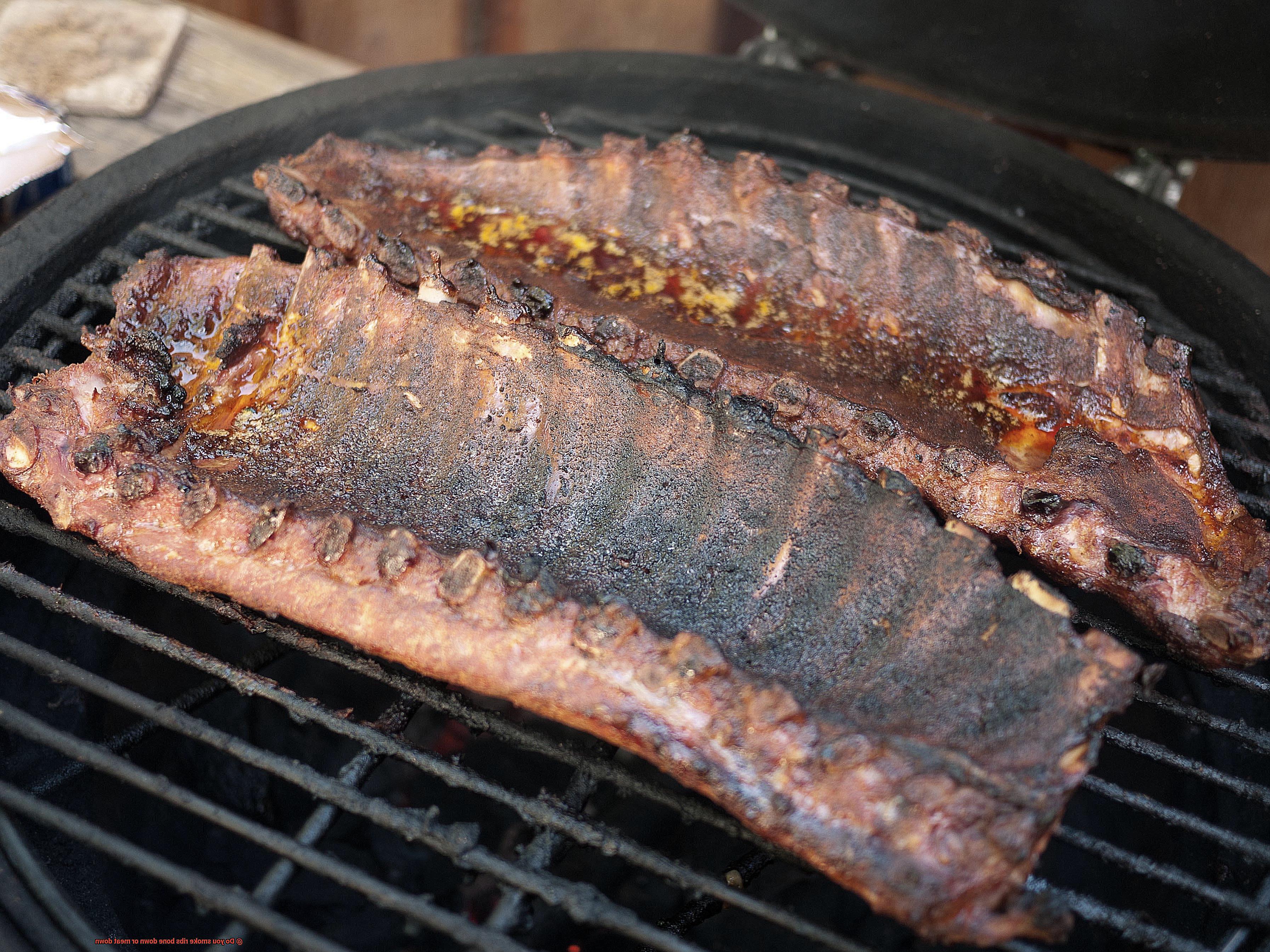
Those who opt for the meat down method argue that it allows for better smoke penetration and creates a delicious bark on the meat side. The direct heat on the meat side also helps to caramelize any rub or sauce that is applied, creating a crispy and flavorful crust.
This method is perfect for those who crave a crispy bark on their ribs. With the meat directly exposed to the heat source, it creates a delicious charred flavor that complements any rub or sauce applied.
The Verdict:
There’s no clear winner when it comes to bone down vs meat down. Ultimately, it comes down to personal preference. Some grill masters swear by one method and refuse to use any other technique, while others prefer to switch things up depending on the occasion.
However, it’s worth noting that many professional pitmasters tend to smoke their ribs bone down. They believe it creates a more consistent and even cook. That being said, don’t be afraid to experiment with both methods and see which one produces the best results for you.
Some additional tips to consider when smoking ribs include using quality wood chips, monitoring the temperature regularly, and keeping the smoke flowing for the entire cooking process. With practice, patience, and attention to detail, you’ll be able to produce mouth-watering fall-off-the-bone tender meat bursting with flavor.
Pros and Cons of Smoking Ribs Bone Down
While there are valid arguments for both sides, in this section, we will explore the pros and cons of smoking ribs bone down.
Firstly, smoking ribs bone-side down is believed to protect the meat from drying out during the cooking process, making it more tender and juicy. The bones act as a natural barrier between the meat and the heat source, preventing overcooking and toughness. Additionally, with the excess fat dripping away from the meat, it results in a leaner and more flavorful finished product.
Furthermore, smoking ribs bone-side down can help to create an even cooking temperature throughout the ribs. The bones distribute heat evenly, preventing hot spots on the meat and resulting in a consistent cook.
However, cooking ribs bone-side down can make it harder to achieve a good bark on the meat. Bark refers to the crispy outer layer that forms on the surface of smoked meats, adding flavor and texture to the finished product. With less direct contact between the meat and heat source, it can be challenging to get that perfect bark.
Another potential downside is that when meat is pressed against the grill grates while cooking bone-side down, it can leave unsightly marks on its surface, leading to a less visually appealing finished product.
Ultimately, the decision to smoke ribs bone-side down or not comes down to personal preference and experimentation. If you prioritize tenderness and even cooking throughout your ribs, bone-side down may be worth considering. However, if you’re after a crispy bark and visually stunning dish, then meat-side down may be worth trying.
Pros and Cons of Smoking Ribs Meat Down
Let’s explore the pros and cons of smoking ribs meat down and help you decide which method is best for your taste buds.
Let’s start with the pros. Cooking ribs meat down protects the meat from direct heat, preventing it from drying out or burning. The bones act as a barrier between the heat source and the meat, ensuring even cooking and juicy, tender ribs. Additionally, cooking the ribs meat down allows the fat and collagen in the meat to melt and baste it, resulting in a rich, flavorful taste. The juices from the meat seep into the smoke, creating an enhanced smoky flavor profile that tantalizes your taste buds.
On the other hand, smoking ribs meat down can reduce smoke penetration, leading to less smoky flavor and a less intense smoke ring. It can also be difficult to baste the meat without flipping it over, making it challenging to achieve the desired texture. Lastly, smoking ribs meat down can limit bark formation, which adds flavor and texture to the ribs.
Factors to Consider When Deciding Between Bone Down or Meat Down
I have researched the factors to consider when making this crucial decision. Let’s explore.
First and foremost, the position of the ribs during smoking plays a significant role in the cooking process. Cooking ribs bone down shields them from direct heat, preventing them from burning or drying out. This results in tender and juicy meat, cooked evenly throughout. However, smoking the ribs meat down allows for better smoke penetration and a crustier bark, adding texture and flavor to the meat.
Another critical factor to consider is the type of smoker being used. If your smoker has varying heat levels, placing the ribs bone down on the cooler side can prevent overcooking. However, if your smoker has consistent heat throughout, smoking the ribs meat down may be better.
Lastly, personal preference is key when deciding between bone down or meat down smoking. Do you prefer a crispy bark or tender and juicy meat? Experimenting with different methods can help determine which style of smoking produces the desired outcome.
Tips for Smoking Ribs Effectively
Smoking ribs is an art that requires patience, skill, and the right equipment. To ensure that you smoke your ribs effectively, there are a few tips that you should keep in mind. Here are five sub-sections to consider:
Choose the Right Cut of Ribs
The first step in smoking ribs is to choose the right cut of meat. While there are different types of ribs available, the most commonly used for smoking are baby back and spare ribs. Baby back ribs are shorter and leaner, while spare ribs are larger and contain more fat. It is crucial to choose ribs that have a good amount of meat on them and are not too fatty.
Prepare the Ribs Properly
Before smoking your ribs, it’s important to prepare them properly. This involves removing the membrane from the back of the rib rack and seasoning the meat with a dry rub or marinade. The dry rub can consist of salt, pepper, paprika, garlic powder, and other spices of your choosing. This will help to add flavor and create a crust on the outside of the meat.
Bone Down or Meat Down?
When it comes to smoking ribs, the way you position them in your smoker can make a significant difference in the final result. One of the most common debates among pitmasters is whether to smoke ribs bone down or meat down. While there is no one right answer, many experts suggest smoking ribs bone down. This allows for better airflow around the meat, which in turn promotes more even cooking and prevents the meat from drying out. Additionally, smoking ribs bone down allows for the fat and connective tissue to render and baste the meat while it cooks.
However, some pitmasters swear by smoking ribs meat down. They argue that this allows the smoke to penetrate the meat more thoroughly, resulting in a deeper smoky flavor.
Meat down may also result in a crisper bark on the top of the ribs. Ultimately, the decision to smoke ribs bone down or meat down will depend on personal preference and the equipment you are using.
Maintain Consistent Temperature
To smoke your ribs effectively, it’s crucial to maintain a consistent temperature throughout the smoking process. This can be achieved by using a smoker with temperature control or by monitoring the temperature manually using a thermometer. The ideal temperature for smoking ribs is between 225-250 degrees Fahrenheit. By maintaining a consistent temperature, you can ensure that your ribs cook evenly and turn out tender and juicy.
Spritz Your Ribs
Another tip for smoking ribs effectively is to spritz them periodically with apple juice or another liquid. This will help to keep them moist and prevent them from drying out. You can also add additional flavor by mixing in spices or herbs with your spritzing liquid. Be sure not to overdo it, though, as too much liquid can wash away the dry rub and affect the texture of the meat.
Different Types of Smokers for Smoking Ribs
When it comes to smoking ribs, the type of smoker you use can make a significant difference in the final result. Let’s take a closer look at the different types of smokers available on the market and their unique features and advantages for smoking ribs.
Charcoal Smokers
For those who love that authentic smoky flavor, charcoal smokers are a great choice. They use charcoal as fuel, which gives the meat a distinct flavor that many people prefer. Charcoal smokers come in a variety of shapes and sizes, including bullet-style, offset, and kettle-style smokers. While they require more attention and maintenance than other types of smokers, they are known for producing exceptional results.
One of the advantages of using a charcoal smoker is the ability to control the temperature and smoke levels by adjusting the air vents. This allows you to customize the flavor and texture of your ribs according to your preferences. Additionally, charcoal smokers can produce a nice crust on the meat, which adds texture and depth to the overall flavor.
Electric Smokers
If you’re new to smoking or don’t have a lot of space for a larger smoker, electric smokers are a great option. They are easy to use and require minimal setup and maintenance. Electric smokers typically come with digital controls that allow you to set the temperature and cooking time precisely.
Electric smokers are also great for those who prefer a more hands-off approach. Once you set the temperature and time, you can sit back and relax while the smoker does all the work. However, some people find that electric smokers don’t produce as much smoke flavor as other types of smokers.
Pellet Smokers
Pellet smokers use wood pellets as fuel, which gives the meat a rich, smoky flavor. They are easy to use and come with digital controls that allow you to set the temperature and cooking time accurately. Pellet smokers are also versatile and can be used for grilling, smoking, roasting, and baking.
One of the advantages of using a pellet smoker is the consistent smoke production. The pellets are automatically fed into the smoker, ensuring that there’s always a steady flow of smoke around the meat. Additionally, pellet smokers are highly efficient and produce very little ash, making cleanup a breeze.
Gas Smokers
Gas smokers use propane or natural gas as fuel and are known for their convenience and ease of use. They heat up quickly and require minimal maintenance. Gas smokers typically come with digital controls that allow you to set the temperature precisely.
Gas smokers are great for those who want to get started quickly without having to fuss with charcoal or wood. They also produce less smoke than other types of smokers, which may be a disadvantage for some people who prefer a stronger smoky flavor in their ribs.
Conclusion
In the end, the debate over whether to smoke ribs bone down or meat down is one that comes down to personal preference and experimentation. Both methods have their merits, with bone down believed to protect the meat from drying out and meat down allowing for better smoke penetration and a delicious bark on the meat side.
To truly master the art of smoking ribs, there are a few key steps to follow. First, choose the right cut of ribs and prepare them properly with a dry rub or marinade. Then, maintain consistent temperature throughout the smoking process and spritz periodically with apple juice or another liquid.
While there are many types of smokers available on the market, it’s important to find one that works best for you. Whether you prefer charcoal smokers for that authentic smoky flavor or electric smokers for their convenience and ease of use, practice and experimentation will help you perfect your technique.
With these tips and techniques provided by experts in this article, you’ll be able to produce mouth-watering fall-off-the-bone tender meat bursting with flavor that will impress your guests every time.

